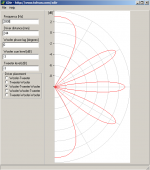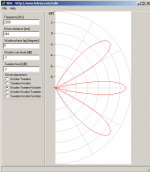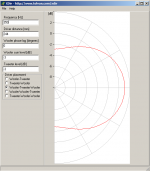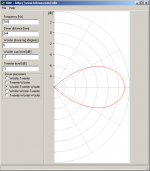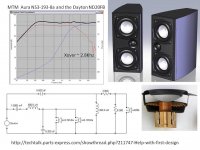Hi Linesource, I hadn't seen Xdir before. Quick question on it's use. I assume the driver distance is CtC distance between the woofers in the case of an MTM (or is it CtC one woofer and tweeter).
The phase lag, I assume if you have good phase matching of the drivers that this can be set to 0 deg?
My MTM does have a very narrow lobe. I don't mind as it was designed to be right when seated. If I put in the CtC for the woofers and 0 deg I get what I would expect so I think that is right
With the default of 90deg phase lag it is woeful!
Tony.
The phase lag, I assume if you have good phase matching of the drivers that this can be set to 0 deg?
My MTM does have a very narrow lobe. I don't mind as it was designed to be right when seated. If I put in the CtC for the woofers and 0 deg I get what I would expect so I think that is right
With the default of 90deg phase lag it is woeful!
Tony.
Aura NS3-193-08 and HiVi TN-25 MTM MLTL
More than 8 years ago I designed a small floor standing MTM MLTL speaker with Aura NS3-193-08 as the M's while the tweeter was the HiVi TN-25. These speakers featured surprising deep bass and great sound for their low cost drivers (the TN-25 is currently about $13 each). I demonstrated them at several DIY events and shared details of their design on an earlier version of the Parts-Express Tech Talk forum.
Later on the P-E Speaker Gallery Forum several members started a thread that documented my design which has been duplicated by several builders as you can read at:
Jim Griffin's Aura T-line 2-way
This link shows the enclosure dimensions and the crossover so other builders can build this design.
The HiVi TN-25 is a 1 inch diameter fabric dome tweeter but its face plate dimensions are 2.13 x 2.13 inches. Hence, perfect for a small MTM with the Aura drivers. Thus a tight C-T-C between these small drivers is easily achieved.
Now this design can be converted to a small bookshelf size MTM. (For what it is worth I have routinely converted several small MTM or TM speakers into MLTL enclosures so going the other way is easily done.) The Aura drivers are adaptable to either a sealed or vented box so a smaller box can be easily conceived. You can use the same crossover as I used within the MLTL version if you maintain the baffle width at 5 inches. The depth or height of the bookshelf version can be adjusted to meet the specs for either the sealed or vented boxes.
For the original poster my experience with the Infinity EMIT tweeters (I owned a pair of RS4b with EMITs for several years) is that the EMITs would need to be crossed at 3500 Hz or higher.
I have also used the small Fountek NeoCD1.0 ribbon tweeter (about $50 at P-E) in versions of Paul Carmody's Speedster TM speakers. Ribbon or planar drivers essentially have a slot aperture so that their vertical plane dispersion trends toward their vertical height as frequency goes up. In the Speedster the Tangband woofer is mounted so that it partially overlaps with the ribbon tweeter which helps to minimize the C-T-C spacing between the drivers. You can see this spacing and placement if you Google 'Speedster Loudspeaker'. Now for a MTM version you could overlap both the upper and lower M's with a ribbon tweeter like the Fountek or the EMIT unit. Hence, the spacing between the drivers can be minimized without impacting the vertical dispersion of the sound.
More than 8 years ago I designed a small floor standing MTM MLTL speaker with Aura NS3-193-08 as the M's while the tweeter was the HiVi TN-25. These speakers featured surprising deep bass and great sound for their low cost drivers (the TN-25 is currently about $13 each). I demonstrated them at several DIY events and shared details of their design on an earlier version of the Parts-Express Tech Talk forum.
Later on the P-E Speaker Gallery Forum several members started a thread that documented my design which has been duplicated by several builders as you can read at:
Jim Griffin's Aura T-line 2-way
This link shows the enclosure dimensions and the crossover so other builders can build this design.
The HiVi TN-25 is a 1 inch diameter fabric dome tweeter but its face plate dimensions are 2.13 x 2.13 inches. Hence, perfect for a small MTM with the Aura drivers. Thus a tight C-T-C between these small drivers is easily achieved.
Now this design can be converted to a small bookshelf size MTM. (For what it is worth I have routinely converted several small MTM or TM speakers into MLTL enclosures so going the other way is easily done.) The Aura drivers are adaptable to either a sealed or vented box so a smaller box can be easily conceived. You can use the same crossover as I used within the MLTL version if you maintain the baffle width at 5 inches. The depth or height of the bookshelf version can be adjusted to meet the specs for either the sealed or vented boxes.
For the original poster my experience with the Infinity EMIT tweeters (I owned a pair of RS4b with EMITs for several years) is that the EMITs would need to be crossed at 3500 Hz or higher.
I have also used the small Fountek NeoCD1.0 ribbon tweeter (about $50 at P-E) in versions of Paul Carmody's Speedster TM speakers. Ribbon or planar drivers essentially have a slot aperture so that their vertical plane dispersion trends toward their vertical height as frequency goes up. In the Speedster the Tangband woofer is mounted so that it partially overlaps with the ribbon tweeter which helps to minimize the C-T-C spacing between the drivers. You can see this spacing and placement if you Google 'Speedster Loudspeaker'. Now for a MTM version you could overlap both the upper and lower M's with a ribbon tweeter like the Fountek or the EMIT unit. Hence, the spacing between the drivers can be minimized without impacting the vertical dispersion of the sound.
I assume the driver distance is CtC distance between the woofers in the case of an MTM
Yes.
dave
Thanks Dave, was just uncertain since there were no instructions with the software  I've been considering doing a revised crossover for some time and playing with this shows me there is a benefit in dropping the crossover frequency from my (high for an MTM) 2800Hz to between 2000 and 2300 Hz....
I've been considering doing a revised crossover for some time and playing with this shows me there is a benefit in dropping the crossover frequency from my (high for an MTM) 2800Hz to between 2000 and 2300 Hz....
No where near the 1/4 wavelength ideal (that would be around 350 Hz for this driver placement) but with a bit of thought I might be able to control the floor and ceiling bounce a bit better (something I've seen AllenB mention).
Mindsource definitely have a play with Xdir, would have been nice to have known about this when I was first doing my design. First pic is what my current 2800hz crossover looks like, second is dropping it to 2200. Third is at ideal 1/4 wavelength (not possible with these drivers) and fourth is at 1/2 wavelength (also not possible with these drivers). But it does show why going 1/4 wave is a benefit (even 1/2 wave is not too bad). I'm actually running at two wavelengths!! Throw in some phase shift and things really start to get ugly!!
Tony.
No where near the 1/4 wavelength ideal (that would be around 350 Hz for this driver placement) but with a bit of thought I might be able to control the floor and ceiling bounce a bit better (something I've seen AllenB mention).
Mindsource definitely have a play with Xdir, would have been nice to have known about this when I was first doing my design. First pic is what my current 2800hz crossover looks like, second is dropping it to 2200. Third is at ideal 1/4 wavelength (not possible with these drivers) and fourth is at 1/2 wavelength (also not possible with these drivers). But it does show why going 1/4 wave is a benefit (even 1/2 wave is not too bad). I'm actually running at two wavelengths!! Throw in some phase shift and things really start to get ugly!!
Tony.
Attachments
Example MTM Rendering: Aura NS3-193-8a and the Dayton ND20FB
Passive crossover parts are estimated ~ $35/speaker
Parts Express Tech Talk forum
Help with first design
Passive crossover parts are estimated ~ $35/speaker
Parts Express Tech Talk forum
Help with first design
Attachments
Thanks Dave, was just uncertain since there were no instructions with the softwareI've been considering doing a revised crossover for some time and playing with this shows me there is a benefit in dropping the crossover frequency from my (high for an MTM) 2800Hz to between 2000 and 2300 Hz....
No where near the 1/4 wavelength ideal (that would be around 350 Hz for this driver placement) but with a bit of thought I might be able to control the floor and ceiling bounce a bit better (something I've seen AllenB mention).
Mindsource definitely have a play with Xdir, would have been nice to have known about this when I was first doing my design. First pic is what my current 2800hz crossover looks like, second is dropping it to 2200. Third is at ideal 1/4 wavelength (not possible with these drivers) and fourth is at 1/2 wavelength (also not possible with these drivers). But it does show why going 1/4 wave is a benefit (even 1/2 wave is not too bad). I'm actually running at two wavelengths!! Throw in some phase shift and things really start to get ugly!!
Tony.
Hello Wintermute.
This is interesting to me as I'm arriving from the other end: I'm in the design phase of the speaker, aware of this phenomenon, have a large tweeter already (TPL), considering MTM in the 2000-2500Hz region, and wondering what's the effect on sound of all of this. Would love to get your input. What issues are you perceiving with the sound you get?
Some folks, including at least a couple speaker manufacturers, have said the magnitude of effect on sound is overrated. Getting first-hand feedback then becomes very important.
Thanks!
If I make a new bezel for the EMITs on the laser cutter, should I bring the transducer as close as possible to the Auras and the Auras as close to each other as possible? Or stick strictly to 1/4 wavelength of crossover frequency?
Should I put some felt between tweeter and mid to reduce diffraction on the driver side of the EMIT?
When we talk about ctc spacing are we talking equal distances between both midrange drivers as well as from midrange to tweeter?
Is acrylic a good material for a bezel or would aluminum be better?
Thanks
Shawn
Should I put some felt between tweeter and mid to reduce diffraction on the driver side of the EMIT?
When we talk about ctc spacing are we talking equal distances between both midrange drivers as well as from midrange to tweeter?
Is acrylic a good material for a bezel or would aluminum be better?
Thanks
Shawn
If I make a new bezel for the EMITs on the laser cutter, should I bring the transducer as close as possible to the Auras and the Auras as close to each other as possible? Or stick strictly to 1/4 wavelength of crossover frequency?
Yes. Anyway you do it, you'll get the CC to 1/4wl.
Ideally all the drivers will be rebated and flush with the baffle.
dave
@ Lewinski,
Could Something like this could be usefull :
O:
..:O
where O are the mids and the 2 : the TPL150H ! A la Proac with the center of the mids at the same horizontal line than the top and bottom of the emissive planar of the AMT ?
If I'm understanding you right, makes no sense to me to use two TPLs per side. Way overkill and way over cost for what you would get.
Hello Wintermute.
This is interesting to me as I'm arriving from the other end: I'm in the design phase of the speaker, aware of this phenomenon, have a large tweeter already (TPL), considering MTM in the 2000-2500Hz region, and wondering what's the effect on sound of all of this. Would love to get your input. What issues are you perceiving with the sound you get?
Some folks, including at least a couple speaker manufacturers, have said the magnitude of effect on sound is overrated. Getting first-hand feedback then becomes very important.
Thanks!
Hi Lewinski, the main issue I have is with room modes. The other "obvious" thing is the narrow on axis lobe (in the vertical plane). The latter is not really going to change from a drop in the crossover frequency (within the range that I can realistically use).
My thinking though is if I get rid of the two big (almost vertical lobes) that I am seeing in the sim, that it may help to reduce the room effects. The secondary thing I am thinking is that the crossover frequency also affects the angle of the two secondary lobes, so adjusting may make it possible to ensure that the first reflections from ceiling and floor do not end up directly at the listening position (they may not be anyway, but at least now I can check this).
I've actually been very happy with the sound of the speakers overall (with the current 2nd revision crossover), It's just been a couple of years now, and getting the itch to see if there are any improvements I can make (as I have learned some more tricks since I designed these). I originally went for a higher crossover frequency because I wasn't sure if the tweeters could handle lower, but I've read plenty of reports that they can with ease.
I've also realised that the problem I was thinking was tweeter distortion (in the first revision crossover) may actually have been woofer breakup, which would also be helped by lowering the xo frequency.
Tony.
Hi Lewinski, the main issue I have is with room modes. The other "obvious" thing is the narrow on axis lobe (in the vertical plane). The latter is not really going to change from a drop in the crossover frequency (within the range that I can realistically use).
My thinking though is if I get rid of the two big (almost vertical lobes) that I am seeing in the sim, that it may help to reduce the room effects. The secondary thing I am thinking is that the crossover frequency also affects the angle of the two secondary lobes, so adjusting may make it possible to ensure that the first reflections from ceiling and floor do not end up directly at the listening position (they may not be anyway, but at least now I can check this).
I've actually been very happy with the sound of the speakers overall (with the current 2nd revision crossover), It's just been a couple of years now, and getting the itch to see if there are any improvements I can make (as I have learned some more tricks since I designed these). I originally went for a higher crossover frequency because I wasn't sure if the tweeters could handle lower, but I've read plenty of reports that they can with ease.
I've also realised that the problem I was thinking was tweeter distortion (in the first revision crossover) may actually have been woofer breakup, which would also be helped by lowering the xo frequency.
Tony.
Thanks Tony. Your experience is interesting. Sounds like your opinion about spaced MTM falls in-between the lobing-is-overrated camp and lobing-is-of-upmost-importance camp. You will be refining your design rather than dropping the idea of MTM with the drivers you have. Good news for me.
As I was reading your post I was wondering what's the frequency of the room modes bugging you? Modes usually are low frequencies and I wonder if the MTM really gets to excite those. Even though Xdir displays those vertical lobes I doubt the frequency range of those lobes does anything to excite the room modes. Said another way: not sure changing xo frequency with affect those modes.
Quite possibly not. It's not something I've experimented with yet, so may not make any difference at all! I don't like to say one way or another unless I've actually tried and measured something.
I have a massive peak at about 40Hz and a substantial dip at around 120Hz. Also some irregularity around 200Hz. It would probably be some time before I could try a revised crossover so I'm afraid I won't be able to provide any thing more concrete for probably a long time... things move slowly around here
Tony.
I have a massive peak at about 40Hz and a substantial dip at around 120Hz. Also some irregularity around 200Hz. It would probably be some time before I could try a revised crossover so I'm afraid I won't be able to provide any thing more concrete for probably a long time... things move slowly around here
Tony.
What do you think about the "Proac Way" with excentred MTM : one near the bottom on the left and one near the top on the right : CtC is reduced like that with a planar tweeter ?
And as well, swapping the L with R speaker provides some versatility about lobying and setups !
good way to do it ?
And as well, swapping the L with R speaker provides some versatility about lobying and setups !
good way to do it ?
Now this design can be converted to a small bookshelf size MTM. (For what it is worth I have routinely converted several small MTM or TM speakers into MLTL enclosures so going the other way is easily done.) The Aura drivers are adaptable to either a sealed or vented box so a smaller box can be easily conceived. You can use the same crossover as I used within the MLTL version if you maintain the baffle width at 5 inches. The depth or height of the bookshelf version can be adjusted to meet the specs for either the sealed or vented boxes.
Hey Jim, I am thinking of going this route using the Aura and HiVi combo, for simplicity. I may take on bigger tasks with the EMITs next year. If I am going for a sealed mtm without BSC what would the crossover look like? Cabinet volume?
Thanks!
Shawn
Great decision. I was concerned that the EMIT driver would necessitate a higher crossover frequency with associated integration problems for a coherent MTM.
Let me ask you to confirm which Aura woofers model number you plan to use. I used NS3-193-08 in my MLTL but more recent NS3 units have been -08a suffix or even -08a1 drivers. Slight differences but I'd rather use your version vs. having to redo the analysis. While measured T/S data would be nice, I typically have good results when I use manufacturers T/S specs to model the enclosure. A sealed box would be more tolerant with minor T/S variance than other alignments.
I would suggest the crossover for my MLTL version can be used 'as is' if you use a 5 inch wide baffle and then place the MTM boxes in vertical positions on your desk. Only if you surround the enclosures with stacks of books or such would you need to redo the crossover.
Let me ask you to confirm which Aura woofers model number you plan to use. I used NS3-193-08 in my MLTL but more recent NS3 units have been -08a suffix or even -08a1 drivers. Slight differences but I'd rather use your version vs. having to redo the analysis. While measured T/S data would be nice, I typically have good results when I use manufacturers T/S specs to model the enclosure. A sealed box would be more tolerant with minor T/S variance than other alignments.
I would suggest the crossover for my MLTL version can be used 'as is' if you use a 5 inch wide baffle and then place the MTM boxes in vertical positions on your desk. Only if you surround the enclosures with stacks of books or such would you need to redo the crossover.
Last edited:
I am using aurasound ns3-193-8a1 for LR channels
and aurasound ns3-193-4a1 for center channel
Unfortunately that's just the way it goes, it's what I've got.
I am mounting the drivers flush into a baffle wall. Simulated it on EDGE and will not need BSC. Just a sealed enclosure that will bring them down to fs to meet the subwoofers.
Thanks!
and aurasound ns3-193-4a1 for center channel
Unfortunately that's just the way it goes, it's what I've got.
I am mounting the drivers flush into a baffle wall. Simulated it on EDGE and will not need BSC. Just a sealed enclosure that will bring them down to fs to meet the subwoofers.
Thanks!
I checked the enclosure size for both a sealed or vented MTM speaker with 2 NS3-193-8A1 drivers. The nominal impedance becomes 4 ohms with a parallel connection.
For the sealed variant in an 5.6 liters (0.2 cu ft) internal volume enclosure the F3 =95 Hz with a Qts of 0.71 (flat response with no peaking). Very nice response but you would need that sub to cover down low. Typical sealed volume fill material is assumed.
For the same size box but with a 38 mm (1.5") diameter by 100 mm (4") long vent you can achieve a F3 = 56 Hz. Typical vented box damping material lining the rear, side, top, and bottom walls is assumed.
External dimension for a 5.6 liters (internal volume) MTM box would be about 250 H x 125 W x 175 D in mm (or 10 x 5 x 7 inches).
For the sealed variant in an 5.6 liters (0.2 cu ft) internal volume enclosure the F3 =95 Hz with a Qts of 0.71 (flat response with no peaking). Very nice response but you would need that sub to cover down low. Typical sealed volume fill material is assumed.
For the same size box but with a 38 mm (1.5") diameter by 100 mm (4") long vent you can achieve a F3 = 56 Hz. Typical vented box damping material lining the rear, side, top, and bottom walls is assumed.
External dimension for a 5.6 liters (internal volume) MTM box would be about 250 H x 125 W x 175 D in mm (or 10 x 5 x 7 inches).
- Status
- This old topic is closed. If you want to reopen this topic, contact a moderator using the "Report Post" button.
- Home
- Loudspeakers
- Multi-Way
- mtm seperate or shared enclosure
